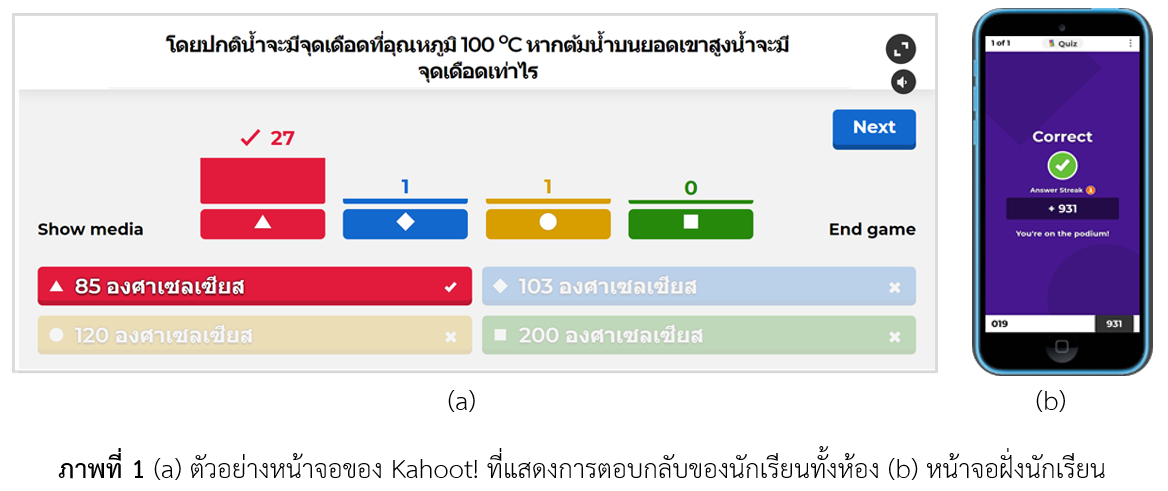ผลของการใช้ Kahoot เป็นเครื่องมือช่วยวัดประเมินผลระหว่างเรียนในการจัดการเรียนรู้แบบ4E×2 ที่มีต่อผลสัมฤทธิ์ทางการเรียนและความสามารถในการคิดวิเคราะห์
Main Article Content
บทคัดย่อ
การวิจัยครั้งนี้มีจุดประสงค์เพื่อ 1) เปรียบเทียบผลสัมฤทธิ์ทางการเรียนในวิชาวิทยาศาสตร์ เรื่อง พลังงานความร้อน ของนักเรียนชั้นมัธยมศึกษาปีที่ 1 ก่อนและหลังการจัดการเรียนรู้แบบ 4E×2 ร่วมกับ Kahoot! 2) เปรียบเทียบความสามารถในการคิดวิเคราะห์ของนักเรียนชั้นมัธยมศึกษาปีที่ 1 ก่อนและหลังการจัดการเรียนรู้แบบ 4E×2 ร่วมกับ Kahoot! และ 3) ศึกษาความพึงพอใจในของนักเรียนชั้นมัธยมศึกษาปีที่ 1 ต่อการจัดการเรียนรู้แบบ 4E×2 ร่วมกับ Kahoot! กลุ่มตัวอย่างในงานวิจัยนี้คือ นักเรียนชั้นมัธยมศึกษาปีที่ 1 โรงเรียนมัธยมศึกษาขนาดใหญ่แห่งหนึ่งในกรุงเทพมหานคร ที่กำลังศึกษาในภาคเรียนที่ 2 ปีการศึกษา 2563 จำนวน 28 คน ซึ่งได้มาโดยการสุ่มแบบกลุ่ม เครื่องมือที่ใช้ในการวิจัยประกอบด้วย แผนการจัดการเรียนรู้แบบ 4E×2 ร่วมกับ Kahoot! แบบทดสอบวัดผลสัมฤทธิ์ทางการเรียน แบบทดสอบวัดความสามารถในการคิดวิเคราะห์ และแบบสอบถามความพึงพอใจต่อการจัดการเรียนรู้ ข้อมูลถูกวิเคราะห์โดยใช้ ค่าเฉลี่ย ส่วนเบี่ยงเบนมาตรฐาน ค่าความก้าวหน้าทางการเรียนที่เพิ่มขึ้นจริง และการทดสอบค่าเฉลี่ยของกลุ่มตัวอย่าง 2 กลุ่มที่ข้อมูลไม่เป็นอิสระต่อกัน ผลการวิจัยพบว่า 1) คะแนนเฉลี่ยของผลสัมฤทธิ์ทางการเรียนของนักเรียนหลังการจัดการเรียนรู้แบบ 4E×2 ร่วมกับ Kahoot! สูงกว่าก่อนการจัดการเรียนรู้อย่างมีนัยสำคัญทางสถิติที่ระดับ 0.01 2) ความสามารถในการคิดวิเคราะห์ของนักเรียนหลังการจัดการเรียนรู้แบบ 4E×2 ร่วมกับ Kahoot! สูงกว่าก่อนการจัดการเรียนรู้อย่างมีนัยสำคัญทางสถิติที่ระดับ 0.01 และ 3) ความพึงพอใจของนักเรียนต่อการจัดการเรียนรู้แบบ 4E×2 ร่วมกับ Kahoot! ในภาพรวมอยู่ในระดับมากที่สุด
Article Details

อนุญาตภายใต้เงื่อนไข Creative Commons Attribution-NonCommercial-NoDerivatives 4.0 International License.
วารสารวิทยาศาสตร์และวิทยาศาสตร์ศึกษา (JSSE) เป็นผู้ถือลิสิทธิ์บทความทุกบทความที่เผยแพร่ใน JSSE นี้ ทั้งนี้ ผู้เขียนจะต้องส่งแบบโอนลิขสิทธิ์บทความฉบับที่มีรายมือชื่อของผู้เขียนหลักหรือผู้ที่ได้รับมอบอำนาจแทนผู้เขียนทุกนให้กับ JSSE ก่อนที่บทความจะมีการเผยแพร่ผ่านเว็บไซต์ของวารสาร
แบบโอนลิขสิทธิ์บทความ (Copyright Transfer Form)
ทางวารสาร JSSE ได้กำหนดให้มีการกรอกแบบโอนลิขสิทธิ์บทความให้ครบถ้วนและส่งมายังกองบรรณาธิการในข้อมูลเสริม (supplementary data) พร้อมกับนิพนธ์ต้นฉบับ (manuscript) ที่ส่งมาขอรับการตีพิมพ์ ทั้งนี้ ผู้เขียนหลัก (corresponding authors) หรือผู้รับมอบอำนาจ (ในฐานะตัวแทนของผู้เขียนทุกคน) สามารถดำเนินการโอนลิขสิทธิ์บทความแทนผู้เขียนทั้งหมดได้ ซึ่งสามารถอัพโหลดไฟล์บทความต้นฉบับ (Manuscript) และไฟล์แบบโอนลิขสิทธิ์บทความ (Copyright Transfer Form) ในเมนู “Upload Submission” ดังนี้
1. อัพโหลดไฟล์บทความต้นฉบับ (Manuscript) ในเมนูย่อย Article Component > Article Text
2. อัพโหลดไฟล์แบบโอนลิขสิทธิ์บทความ (Copyright Transfer Form) ในเมนูย่อย Article Component > Other
ดาวน์โหลด ไฟล์แบบโอนลิขสิทธิ์บทความ (Copyright Transfer Form)
เอกสารอ้างอิง
Bundasak, T., Chaowiang, K. and Jangasem, N. (2017). Happily learning among nursing students (in Thai). Journal of MCU Peace Studies, 5(1), 357–369.
Bureau of Educational Testing, Office of the basic Education Commission. (2012). Handbook of a competency appraisal for basic education students based on the basic education core curriculum B.E. 2551 (A.D. 2008) (in Thai). Bangkok: National Office Of Buddhism Press.
Chaiyo, Y. and Nokham, R. (2017). The effect of kahoot, quizizz and google forms on the student’s perception in the classrooms response system. 2017 International Conference on Digital Arts, Media and Technology (ICDAMT), 178–182.
Chareonwongsak, K. (2010). Analytical thinking (in Thai). Bangkok: Success Media Co., Ltd.
Chuenban, T. and Chanchusakun, S. (2020). The development of mathematics problem solving using 4ex2 instructional model with games technique for sixth grade students (in Thai). Silpakorn Educational Research Journal, 12(1), 147–160.
Fotaris, P., Mastoras, T., Leinfellner, R. and Rosunally, Y. (2016). Climbing up the leaderboard: an empirical study of applying gamification techniques to a computer programming class. Electronic Journal of E-Learning, 14, 95–110.
Hake, R. (1998). Interactive-engagement versus traditional methods: a six-thousand-student survey of mechanics test data for introductory physics courses. American Journal of Physics, 66(1), 64–74.
Ismail, M. A., Ahmad, A., Mohammad, J. A., Fakri, N., Nor, M. and Pa, M. (2019). Using kahoot! as a formative assessment tool in medical education: a phenomenological study. BMC Medical Education, 19(1), 230.
Keawsingam, T. (2011). Effects of using the 4ex2 instructional model on concepts about light and vision and skills in interpreting data and making conclusion of lower secondary school students (in Thai). Master’s Thesis. Bangkok: Chulalongkorn University.
Lemlech, J. K. (1994). Curriculum and instructional methods for the elementary and middle school. New York: Macmillan College Publishing Company.
Licorish, S. A., Owen, H. E., Daniel, B. and George, J. L. (2018). Students’ perception of kahoot!’s influence on teaching and learning. Research and Practice in Technology Enhanced Learning, 13(9), 1–23.
Marshall, J. C., Horton, B. and Smart, J. (2009). 4E×2 instructional model: uniting three learning constructs to improve praxis in science and mathematics classrooms. Journal of Science Teacher Education, 20(6), 501–516.
National Institute of Educational Testing Service. (2019). Summary on o-net test results of grade 6 in the academic year 2019 (in Thai). Retrieved 6 June 2021, from NIETS: http://www.newonetresult.niets.or.th/AnnouncementWeb/PDF/SummaryONETM3_2562.pdf.
Nkhoma, C., Nkhoma, M., Thomas, S., Tu, L. K. and Le, N. Q. (2018). Gamifying a flipped first year accounting classroom using kahoot!. International Journal of Information System and Engineering, 6(2), 93–115.
On-nangyai, P. (2012). Construction of analytical thinking ability test for prathomsuksa VI students of education division bangkok metropolitan administration (in Thai). Master’s Thesis. Bangkok: Srinakharinwirot University.
Ounlamai, P. and Boonprajak, D. (2019). The application of kahoot programin trigonometry learning enhancement activity for mathayom suksa 4 students in pramoch wittaya ramintra school (in Thai). Phranakhon Rajabhat Research Journal (Humanities and Social Sciences), 14(1), 176-191.
Pornkul, C. (2011). Teaching the thinking process: theory and adoption (in Thai). Bangkok: Chulalongkorn University press.
Ratniyom, J., Nampa, S., Sudsin, M. and Lee, A. (2020). The effects of cooperative learning management using learning together (lt) technique with mind maps on grade 7 students’ learning achievement and analytical thinking abilities on process of weather change (in Thai). Walailak Journal of Learning Innovations, 6(1), 37–64.
Sarkar, N., Ford, W. and Manzo, C. (2017). Engaging digital natives through social learning. Systemics, Cybernetics and Informatics, 15(2), 1–4.
Sutharat, W. (2004). Thinking and creative thinking (in Thai). Bangkok: Suweerivasarn Press.
The Institute For The Promotion Of Teaching Science And Technology. (2021). Pisa 2018 results: reading, maths and science (in Thai). Retrieved 6 June 2021, from PISA THAILAND: https://pisathailand.ipst.ac.th/pisa2018-fullreport/.
Theeramethakul, S. and Art-in, S. (2020). The development of mathematics problem solving and analytical thinking abilities for grade 8 students using 4e×2 instructional model (in Thai). Journal of Graduate MCU KhonKaen Campus, 7(3), 210–225.
Tongchai, A., Arayathanitkul, K., Soankwan, C., Emarat, N. and Chitaree, R. (2007). A new assessment method by using pre-test and post-test scores (in Thai). HCU Journal, 11(21), 86–94.
Wang, A. I. and Tahir, R. (2020). The effect of using kahoot! for learning–a literature review. Computers & Education, 149, 103818.
Yapici, I. and Karakoyun, F. (2017). Gamification in biology teaching: a sample of kahoot application. Turkish Online Journal of Qualitative Inquiry, 8, 396–414.


